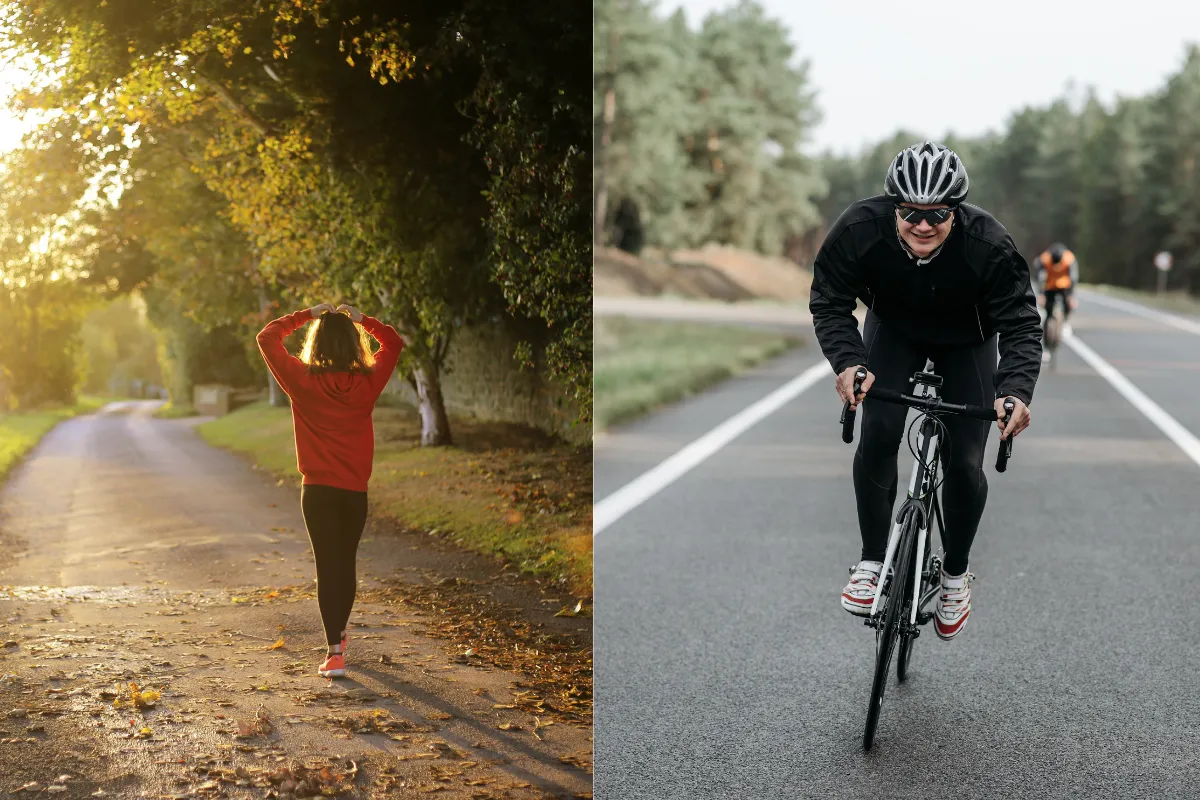In the realm of fitness and exercise, the debate between cycling and walking often arises.
Both activities offer numerous health benefits and are accessible to people of various fitness levels.
However, when it comes to choosing between cycling and walking as a primary workout, individuals may wonder which option is superior for achieving their fitness goals.
This article aims to explore the advantages and drawbacks of both cycling and walking to help readers make an informed decision about which activity suits their needs best.
Cycling: The Pros and Cons
Cycling, whether outdoors or indoors on a stationary bike, has gained popularity for its cardiovascular benefits, low impact on joints, and potential for high-intensity workouts. Here are some of the key advantages and disadvantages of cycling as a form of exercise:
Advantages of Cycling:
Cardiovascular Health:
Cycling is an excellent aerobic exercise that gets the heart pumping and improves cardiovascular health.
Regular cycling can lower the risk of heart disease, stroke, and hypertension.
Low Impact:
Unlike running or high-impact activities, cycling is gentle on the joints, making it suitable for individuals with joint pain or those recovering from injuries.
Muscle Engagement:
Cycling primarily targets the lower body muscles, including the quadriceps, hamstrings, calves, and glutes.
It also engages the core muscles to maintain balance and stability.
Versatility:
Cycling can be adapted to various terrains and intensities, allowing individuals to customize their workouts based on their fitness levels and goals.
Outdoor Enjoyment:
Cycling outdoors offers the added benefit of being in nature, which can reduce stress levels and enhance overall well-being.
Disadvantages of Cycling:
Equipment Cost:
Purchasing a quality bicycle and necessary gear can be expensive, especially for those looking for specialized bikes such as road bikes or mountain bikes.
Safety Concerns:
Cycling on roads poses risks, including accidents with motor vehicles and falls. Proper safety precautions, such as wearing a helmet and obeying traffic rules, are essential.
Weather Dependency:
Outdoor cycling is weather-dependent, which may limit opportunities for exercise during inclement weather conditions.
Limited Upper Body Engagement While cycling strengthens the lower body muscles, it offers minimal engagement of the upper body muscles, which may be a drawback for individuals seeking full-body workouts.
Walking: The Pros and Cons
Walking is a simple yet effective form of exercise that requires minimal equipment and can be performed almost anywhere. Let’s explore the advantages and disadvantages of walking as a workout:
Advantages of Walking:
Accessibility:
Walking requires no special equipment other than a comfortable pair of shoes, making it accessible to almost everyone regardless of age or fitness level.
Low Risk of Injury:
Walking is a low-impact activity that puts minimal stress on the joints, making it suitable for individuals with arthritis, osteoporosis, or joint issues.
Weight Management:
Regular walking can aid in weight management by burning calories and increasing metabolism.
It is an effective exercise for those looking to lose weight or maintain a healthy weight.
Mental Health Benefits:
Walking has been shown to reduce stress, anxiety, and depression while improving mood and cognitive function.
It provides an opportunity for mindfulness and relaxation, especially when done outdoors in natural surroundings.
Social Engagement:
Walking can be a social activity when done with friends, family, or walking groups, providing an opportunity for social interaction and support.
Disadvantages of Walking:
Lower Intensity:
While walking offers numerous health benefits, it may not provide as intense a workout as cycling, especially for individuals seeking high-intensity cardiovascular exercise.
Time Requirement:
Achieving significant fitness gains through walking may require a greater time commitment compared to higher-intensity activities like cycling or running.
Limited Muscle Engagement:
Walking primarily targets the lower body muscles, with minimal engagement of the upper body or core muscles.
Monotonous:
Some individuals may find walking monotonous, especially if they follow the same route or pace each time, which could lead to boredom and reduced motivation.
Comparing Cycling and Walking:
Now that we’ve examined the pros and cons of both cycling and walking, let’s compare them in various aspects to help determine which activity may be better suited for different individuals:
Cardiovascular Benefits:
Both cycling and walking offer significant cardiovascular benefits, but cycling may provide a more intense workout, leading to greater improvements in cardiovascular fitness.
Impact on Joints:
Walking is generally gentler on the joints compared to cycling, making it a better option for individuals with joint pain or mobility issues.
Muscle Engagement:
Cycling primarily targets the lower body muscles, while walking engages both the lower body and core muscles to a lesser extent.
Time Efficiency:
Cycling typically allows for faster calorie burning and fitness gains compared to walking, making it a more time-efficient option for those with busy schedules.
Cost and Accessibility:
Walking requires minimal equipment and can be done almost anywhere for free, while cycling may require a significant investment in equipment and gear.
Conclusion:
Both cycling and walking are excellent forms of exercise with unique advantages and disadvantages.
Ultimately, the best workout for you depends on your fitness goals, preferences, and individual circumstances.
If you’re looking for a low-impact, accessible activity that promotes mental well-being and social interaction, walking may be the ideal choice.
On the other hand, if you prefer a higher-intensity workout that targets specific muscle groups and offers versatility in terrain and intensity, cycling might be more suitable.
Regardless of which activity you choose, consistency and enjoyment are key factors in achieving long-term fitness success.
So, lace up your shoes or hop on your bike, and embark on a journey to a healthier, happier you!
